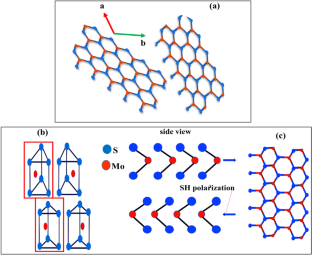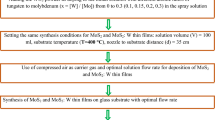Abstract
Transition metal dichalcogenides, particularly Molybdenum Disulphide (MoS2), have garnered significant attention in scientific research due to their remarkable optoelectrical characteristics. In this study, the characteristics of MoS2 flakes deposited on indium tin oxide (ITO) glass slides coated with polyvinyl alcohol (PVA) were investigated. The influence of a strain stimulus provided by a nematic liquid crystal (NLC) called 5CB on the MoS2 structure was studied using Raman polar plots, revealing its potential as an electrically controlled light controller. The analysis of Raman Shift showed that the application of tensile strain-induced defects in the MoS2 structure resulted in a lowered bandgap energy level. Photoluminescence (PL) spectroscopy demonstrated that the combination of 5CB and an electric field enhanced the exciton lifetime and decreased the bandgap energy levels. The study employed theoretical and computational modeling of PL/Raman techniques for qualitative and quantitative analysis of the PVA-coated ITO-MoS2 sample. The utilization of Mathematica v 9.0 contributed to the accuracy and reliability of the results, ensuring robust analysis and interpretation of the experimental data. These findings contribute to the understanding of strain-induced effects on MoS2 and highlight the potential of using NLCs for optoelectronic control in MoS2-based devices.








Similar content being viewed by others
Data availability
The data used in this research will be made available upon request.
Abbreviations
- TMDCs:
-
Transition metal dichalcogenides
- 2D:
-
Two dimensional
- NbS2 :
-
Niobium sulphide
- TaS2 :
-
Tantalum sulphide
- eV:
-
Electron volt
- V:
-
Volt
- ITO:
-
Indium doped tin oxide
- MoS2 :
-
Molybdenum sulphide
- PVA:
-
Polyvinyl alcohol
- LCs:
-
Liquid crystals
- NLCs:
-
Nematic liquid crystals
- PDMS:
-
Polydimethylsiloxane
- E-field:
-
Electric field
- PL:
-
Photoluminescence
References
Z. Wang, B. Mi, Environmental applications of 2D molybdenum disulfide (MoS2) nanosheets. Environ. Sci. Technol. 51, 8229–8244 (2017)
N. Thomas, S. Mathew, K.M. Nair, K. O’Dowd, P. Forouzandeh, A. Goswami, G. McGranaghan, S.C. Pillai, 2D MoS2: structure, mechanisms, and photocatalytic applications. Mater. Today Sustain. 13, 100073 (2021)
Z. Ye, C. Tan, X. Huang, Y. Ouyang, L. Yang, Z. Wang, M. Dong, Emerging MoS2 wafer-scale technique for integrated circuits. Nano-Micro Lett. 15, 38 (2023)
Z. Wang, X. Xiong, J. Li, M. Dong, Screening fermi-level pinning effect through van der waals contacts to monolayer MoS2. Mater. Today Phys. 16, 100290 (2021)
M. Mohan, N.P. Shetti, T.M. Aminabhavi, Phase dependent performance of MoS2 for supercapacitor applications. J. Energy Storage 58, 106321 (2023)
A. Altibelli, C. Joachim, P. Sautet, Interpretation of STM images: the MoS2 surface. Surf. Sci. 367, 209–220 (1996)
S. Parmar, S. Panchal, S. Datar, S. Ogale, Semiconductor-semimetal 2D/3D MoS2/SrRuO3 (111) TMD/TMO heterojunction-based ReRAM devices. ACS Appl. Electron. Mater. 5, 5588–5597 (2023)
S. Parmar, A. Biswas, B. Ray, S. Gosavi, S. Datar, S. Ogale, Stabilizing metastable polymorphs of van der Waals solid MoS2 on single crystal oxide substrates: exploring the possible role of surface chemistry and structure. J. Phys. Chem. C 125, 11216–11224 (2021)
I.M. Datye, A. Daus, R.W. Grady, K. Brenner, S. Vaziri, E. Pop, Strain-enhanced mobility of monolayer MoS2. Nano Lett. 22, 8052–8059 (2022)
D.R. Kripalani, P.-P. Sun, P. Lin, M. Xue, K. Zhou, Strain-driven superplasticity of ultrathin tin (II) oxide films and the modulation of their electronic properties: a first-principles study. Phys. Rev. B 100, 214112 (2019)
B.H. Kim, M. Park, M. Lee, S.J. Baek, H.Y. Jeong, M. Choi, S.J. Chang, W.G. Hong, T.K. Kim, H.R. Moon, Effect of sulphur vacancy on geometric and electronic structure of MoS2 induced by molecular hydrogen treatment at room temperature. RSC Adv. 3, 18424–18429 (2013)
M. López-Suárez, I. Neri, R. Rurali, Band gap engineering of MoS2 upon compression. J. Appl. Phys. (2016). https://doi.org/10.1063/1.4948376
X. Li, H. Zhu, Two-dimensional MoS2: properties, preparation, and applications. J. Materiomics 1, 33–44 (2015)
K.M. Herbert, H.E. Fowler, J.M. McCracken, K.R. Schlafmann, J.A. Koch, T.J. White, Synthesis and alignment of liquid crystalline elastomers. Nat. Rev. Mater. 7, 23–38 (2022)
H. Ayeb, M. Derbali, A. Mouhli, T. Soltani, F. Jomni, J. Fresnais, E. Lacaze, Viscoelastic and dielectric properties of 5CB nematic liquid crystal doped by magnetic and nonmagnetic nanoparticles. Phys. Rev. E 102, 052703 (2020)
N.Y. Canli, D. Özükanar, D. Vardar, P. Kavak, A.A. Bozkurt, H. Ocak, B.B. Eran, Determination of dielectric properties of 5CB nematic liquid crystal doped with new chiral calamitic compounds. J. Mater. Sci.: Mater. Electron. 34, 1304 (2023)
D.V. Shmeliova, S.V. Pasechnik, S.S. Kharlamov, A.V. Zakharov, E.P. Pozhidaev, V.A. Barbashov, T.P. Tkachenko, Capillary flows of nematic liquid crystal. Crystals 10, 1029 (2020)
X. Zhan, D. Luo, K.-L. Yang, Multifunctional sensors based on liquid crystals scaffolded in nematic polymer networks. RSC Adv. 11, 38694–38702 (2021)
E. Blundo, C. Di Giorgio, G. Pettinari, T. Yildirim, M. Felici, Y. Lu, F. Bobba, A. Polimeni, Engineered creation of periodic giant, nonuniform strains in MoS2 monolayers. Adv. Mater. Interfaces 7, 2000621 (2020)
G. Pathak, G. Shukla, A. Srivastava, O. Strzezysz, R. Manohar, Dispersion of nanoparticles into the low birefringent nematic liquid crystal: study of optical and electro-optical parameters and its applicability towards liquid crystal displays. J. Theor. Appl. Phys. 14, 51–59 (2020)
P. Tripathi, D. Singh, T. Yadav, V. Singh, A. Srivastava, Y. Negi, Enhancement of birefringence for liquid crystal with the doping of ferric oxide nanoparticles. Opt. Mater. 135, 113298 (2023)
L.-L. Ma, C.-Y. Li, J.-T. Pan, Y.-E. Ji, C. Jiang, R. Zheng, Z.-Y. Wang, Y. Wang, B.-X. Li, Y.-Q. Lu, Self-assembled liquid crystal architectures for soft matter photonics. Light Sci. Appl. 11, 270 (2022)
J.-S. Yu, J.-J. Hwang, D.-H. Kim, J.-H. Kim, Anchoring strength of a nematic liquid crystal on 2D materials. Liq. Cryst. 50, 674–680 (2023)
A. Shabbir, Z. Khan, A. Ali, W. Qasim, N. Ahmad, Z. Hussain, H. Pervaiz, Diamond-like carbon film deposited via electrochemical route for antireflection applications in photovoltaic. Key Eng. Mater. 928, 163–175 (2022)
J. Wang, Z. Ji, G. Yang, X. Chuai, F. Liu, Z. Zhou, C. Lu, W. Wei, X. Shi, J. Niu, Charge transfer within the F4TCNQ-MoS2 van der Waals Interface: toward electrical properties tuning and gas sensing application. Adv. Func. Mater. 28, 1806244 (2018)
A.R. Dogra, V. Sharma, P. Malik, P. Kumar, Fabrication and characterization of multilayer self assembled silica nanoparticles in a confined empty ito cell with in-situ homeotropic alignment of dye doped liquid crystal for display devices, Available at SSRN 4583154
A. Shabbir, Z. Hussain, Z.S. Khan, W. Qasim, Morphology matters: investigating the influence of granules and nanofibers on the physicochemical properties of TiO2 for optoelectronic applications. Opt. Mater. 146, 114525 (2023)
V.J. Cicily Rigi, M.K. Jayaraj, K.J. Saji, Effect of substrate and substrate temperature on the deposition of MoS2 by radio frequency magnetron sputtering. J. Vacuum Sci. Technol A (2022). https://doi.org/10.1116/6.0001685
V.Y. Reshetnyak, and Taras Shevchenko National University of Kyiv Kyiv Ukraine. Theoretical modeling of liquid crystal based tunable metamaterials. 0024 (2019)
J. Gao, Y.D. Kim, L. Liang, J.C. Idrobo, P. Chow, J. Tan, B. Li, L. Li, B.G. Sumpter, T.-M. Lu, Transition-metal substitution doping in synthetic atomically thin semiconductors. Adv. Mater. 28, 9735 (2016)
C. Vidya, C. Manjunatha, A. Pranjal, I. Faraaz, K. Prashantha, A multifunctional nanostructured molybdenum disulphide (MoS2): an overview on synthesis, structural features, and potential applications. Mater. Res. Innov. 27, 177–193 (2023)
Y.V. Zhumagulov, A. Vagov, D.R. Gulevich, P.E. Faria Junior, V. Perebeinos, Trion induced photoluminescence of a doped MoS2 monolayer. J. Chem. Phys. (2020). https://doi.org/10.1063/5.0012971
S. Golovynskyi, I. Irfan, M. Bosi, L. Seravalli, O.I. Datsenko, I. Golovynska, B. Li, D. Lin, J. Qu, Exciton and trion in few-layer MoS2: thickness-and temperature-dependent photoluminescence. Appl. Surf. Sci. 515, 146033 (2020)
D. Mastrippolito, S. Palleschi, G. D’Olimpio, A. Politano, M. Nardone, P. Benassi, L. Ottaviano, Exciton–phonon coupling and power dependent room temperature photoluminescence of sulphur vacancy doped MoS2 via controlled thermal annealing. Nanoscale 12, 18899–18907 (2020)
T. Verhagen, V.L. Guerra, G. Haider, M. Kalbac, J. Vejpravova, Towards the evaluation of defects in MoS2 using cryogenic photoluminescence spectroscopy. Nanoscale 12, 3019–3028 (2020)
J.-S. Yu, J.-J. Hwang, J.-Y. Lee, D.H. Ha, J.-H. Kim, Tuning photoluminescence spectra of MoS2 with liquid crystals. Nanoscale 13, 16641–16648 (2021)
H.C. Foley, Introduction to chemical engineering analysis using mathematica: for chemists biotechnologists and materials scientists (Academic Press, 2021)
M. Sayraç, Computation of refractive index values of inert gases at near infrared and XUV region based on mathematica software. Adıyaman Univ. J. Sci. 11, 48–58 (2021)
P. Taank, R. Karmakar, R. Sharma, R.K. Yadav, M. Shrivastava, N.C. Maurya, T.K. Maji, D. Karmakar, K.V. Adarsh, An insightful picture of multi-particle recombination in few-layer MoS2 nanosheets. J. Phys. Chem. C 126, 416–422 (2022)
M.D. Haque, M.H. Ali, M.F. Rahman, A.Z.M.T. Islam, Numerical analysis for the efficiency enhancement of MoS2 solar cell: a simulation approach by SCAPS-1D. Opt. Mater. 131, 112678 (2022)
Y.R. Farah, Accessing molecular structure and dynamics of photoelectrochemical systems with nonlinear optical spectroscopy, Colorado State University, (2022)
A. Zarnescu, Mathematical problems of nematic liquid crystals: between dynamical and stationary problems. Phil. Trans. R. Soc. A 379(2201), 20200432 (2021)
S. Pandey, Effect of temperature, concentration of precursors and distance between precursors on the synthesis of molybdenum disulfide (MoS2) using chemical vapor deposition (CVD) technique-CVD grown monolayer MoS2 based RRAM, Delhi Technological University, (2021)
Funding
The authors have not disclosed any funding.
Author information
Authors and Affiliations
Contributions
M. Kashif contributed to the manuscript writing, and literature review, and conducted experimental and modeling for the research. Altamash Shabbir contributed to the manuscript writing, literature review, and Modeling Design and critically reviewed and revised the work. Both authors actively participated in the research process and contributed to the development and completion of the study.
Corresponding author
Ethics declarations
Competing interest
The authors declare that they have no personal or financial interests that may have influenced the research conducted in this study.
Additional information
Publisher's Note
Springer Nature remains neutral with regard to jurisdictional claims in published maps and institutional affiliations.
Rights and permissions
Springer Nature or its licensor (e.g. a society or other partner) holds exclusive rights to this article under a publishing agreement with the author(s) or other rightsholder(s); author self-archiving of the accepted manuscript version of this article is solely governed by the terms of such publishing agreement and applicable law.
About this article
Cite this article
Kashif, M., Shabbir, A. Electric field-induced changes in photoluminescence and Raman spectra of MoS2 on PVA-coated conductive substrate with nematic liquid crystals: a combined numerical and experimental study. J Mater Sci: Mater Electron 35, 954 (2024). https://doi.org/10.1007/s10854-024-12714-1
Received:
Accepted:
Published:
DOI: https://doi.org/10.1007/s10854-024-12714-1



